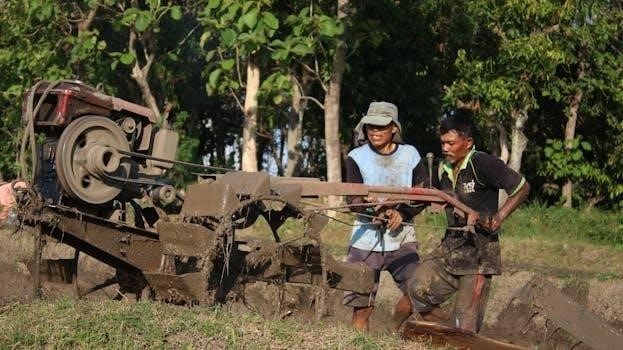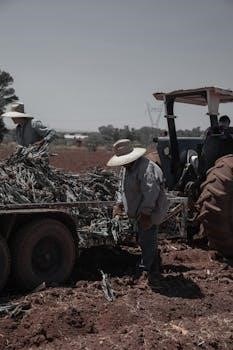
Plow Manual⁚ A Comprehensive Guide
This manual provides essential information for farmers, gardeners, and anyone utilizing plows. It covers selection, operation, maintenance, and safety. Learn to maximize efficiency and ensure longevity of your plow through proper usage.
The plow is a fundamental agricultural tool, dating back to the beginning of farming. Its primary purpose is to till the soil, preparing it for planting. This involves cutting, lifting, and turning over the earth, bringing fresh nutrients to the surface and burying crop residue. In doing so, plows also assist in weed control, creating a clean seedbed. Initially powered by humans or animals, modern plows are predominantly tractor-pulled, significantly increasing efficiency. Different types of plows exist, each suited for specific soil conditions and farming practices. Moldboard plows are known for their ability to completely invert the soil, while disc plows excel in difficult terrains like dry or rocky soil. Understanding the basic principles of plowing is crucial for optimizing crop yields and maintaining soil health. Proper plow usage contributes to improved seed germination, plant growth, and overall farm productivity. This manual serves as a comprehensive guide to understanding and effectively utilizing plows in various agricultural settings. Regular maintenance is vital for sustained performance, including cleaning, lubrication, and blade sharpening. Choosing the right plow for your tractor is important. Thoroughly clean the plow after each use. The plow is the basic tool for growing crops.
Types of Plows⁚ Moldboard vs. Disc

Two primary types of plows dominate agricultural practices⁚ the moldboard plow and the disc plow. The moldboard plow, one of the oldest and most conventional plows, features a large, curved bottom attached to a frame. Its main function is to slice and invert a layer of soil, burying crop residues and leaving a rough soil surface. This complete inversion aids in weed control and incorporates organic matter into the soil. Moldboard plows are suitable for both wet and dry conditions, making them versatile for various farming systems. The disc plow, on the other hand, utilizes rotating discs to cut and turn the soil. Discs are angled backwards, allowing the plow to reach greater depths. Disc plows excel in difficult terrains such as dry soil, rocky areas, and shrub-filled land. They are also beneficial in sticky soil due to reduced friction compared to moldboard plows. While moldboard plows provide thorough soil inversion, disc plows offer advantages in challenging soil conditions and require less maintenance. Each type has unique benefits; thus, selecting the appropriate plow depends on specific soil types and farming requirements. Understanding the strengths and limitations of both moldboard and disc plows is essential for optimizing tillage practices and achieving desired soil conditions for planting.
Plow Components and Their Functions
Understanding the components of a plow and their respective functions is crucial for efficient operation and maintenance. A typical plow consists of several key parts, each playing a vital role in the plowing process. The moldboard is the curved part of the plow that lifts, turns, and inverts the soil. Its shape determines the extent of soil inversion and the resulting surface finish. The share is the cutting edge of the plow, responsible for slicing through the soil horizontally. It is usually made of hardened steel to withstand abrasion and impact. The landside is a flat plate that runs along the furrow wall, providing stability to the plow and counteracting the side draft caused by the soil resistance. The frog is the main frame to which the moldboard, share, and landside are attached. It provides structural support and ensures proper alignment of the components. The coulter is a vertical blade or disc that cuts through the soil ahead of the share, reducing the amount of soil resistance and improving the plow’s ability to penetrate the ground. The jointer is a small moldboard that turns over a small furrow slice ahead of the main moldboard, burying surface trash and improving the quality of the plowing. The beam is the main structural member of the plow, connecting it to the tractor or draft animal. It must be strong enough to withstand the forces generated during plowing. The hitch connects the plow to the power source and allows for adjustments to control the depth and angle of the plow. Each component contributes to the overall performance of the plow, and proper maintenance and adjustment of these parts are essential for achieving optimal plowing results. Regular inspection and replacement of worn or damaged parts will ensure the plow operates efficiently and effectively.
Proper Plow Usage Techniques

Employing proper plowing techniques is paramount for achieving optimal soil conditions for planting and maximizing crop yields. Before commencing, assess the field to determine the appropriate plowing depth and speed based on soil type, moisture content, and crop requirements. Begin by setting the plow to the desired depth, ensuring that the share penetrates the soil effectively without excessive drag. Maintain a consistent plowing speed, typically between 3 to 5 miles per hour, to achieve uniform furrow slices and minimize soil compaction. When plowing, overlap each furrow slice slightly, ensuring complete soil inversion and burial of surface residue. This practice helps to control weeds, break down organic matter, and improve soil aeration. For optimal results, plow in a consistent pattern, such as a clockwise or counterclockwise direction, to avoid creating dead furrows or ridges. When encountering obstacles such as rocks or roots, slow down and carefully maneuver the plow to prevent damage to the equipment or injury to the operator. Regularly monitor the plow’s performance, making adjustments as needed to maintain consistent plowing depth and furrow width. After plowing, consider using a harrow or other secondary tillage implement to break up clods and level the soil surface, creating a smooth seedbed for planting. Always prioritize safety by wearing appropriate personal protective equipment, such as safety glasses and gloves, and following all manufacturer’s recommendations for plow operation. By adhering to these proper plowing techniques, you can ensure efficient soil preparation, improved crop establishment, and ultimately, higher yields. Remember to consult local agricultural extension services for specific recommendations tailored to your region and soil conditions. Proper maintenance of your plow, as detailed in other sections, is also crucial for optimal performance and longevity.
Maintenance of Plow Blades and Other Parts
Regular maintenance of plow blades and other components is essential for sustained performance, optimal soil engagement, and extended equipment lifespan. After each use, thoroughly clean the plow to remove soil, debris, and crop residue. Use a pressure washer or stiff brush to dislodge stubborn material, paying particular attention to the blades, moldboard, and share. Inspect the blades for signs of wear, damage, or dullness. Sharpen dull blades using a grinder or file, ensuring that the cutting edge is restored to its original angle. Replace severely worn or damaged blades promptly to maintain proper plowing performance and prevent further damage to other components. Lubricate all moving parts, such as hinges, joints, and bearings, with a high-quality grease or oil to reduce friction and prevent rust. Check the plow frame and other structural components for cracks, bends, or other signs of damage. Repair or replace damaged parts as needed to ensure the plow’s structural integrity and safe operation. Inspect the plow’s hitch and mounting hardware for wear or looseness. Tighten any loose bolts or nuts and replace worn hitch components to maintain a secure connection between the plow and tractor. Store the plow in a dry, sheltered location when not in use to protect it from the elements and prevent rust. Coat the soil-engaging surfaces with oil or a rust inhibitor to further protect them from corrosion. Regularly inspect the plow’s hydraulic system, if equipped, for leaks or damage. Repair or replace any faulty hoses or cylinders to ensure proper hydraulic function. By following these maintenance practices, you can keep your plow in top condition, ensuring reliable performance and extending its lifespan. Consult the manufacturer’s manual for specific maintenance recommendations and schedules; Remember that proactive maintenance is key to preventing costly repairs and maximizing the return on your investment. A well-maintained plow will contribute to efficient soil preparation and improved crop yields for years to come.

Adjusting Plow Settings for Different Soil Conditions
Achieving optimal plowing results requires careful adjustment of plow settings to match specific soil conditions. Different soil types and moisture levels demand variations in depth, angle, and other parameters. In dry, hard soil, increase the plowing depth to ensure adequate soil penetration and inversion. This may require adjusting the plow’s depth control mechanism or adding weight to the plow frame. Reduce plowing speed to allow the blades to effectively cut through the compacted soil. For wet, sticky soil, decrease the plowing depth to prevent the plow from becoming bogged down. Increase plowing speed to help the soil flow more smoothly over the moldboard and reduce clogging. Adjust the moldboard angle to improve soil shedding and prevent buildup. In sandy soil, maintain a moderate plowing depth to avoid excessive soil disturbance and erosion. Increase plowing speed to help compact the soil and reduce wind erosion. Adjust the coulter to ensure clean cutting and prevent soil from spilling over the moldboard. For rocky soil, reduce the plowing depth to avoid damaging the plow blades or encountering large rocks. Increase plowing speed to help the plow ride over smaller rocks. Consider using a plow with a trip mechanism to protect the blades from damage when encountering larger obstacles. In clay soil, increase the plowing depth to break up the compacted soil structure. Reduce plowing speed to allow the soil to crumble and aerate. Adjust the moldboard extension to improve soil inversion and bury crop residue. When plowing on slopes, adjust the plow’s leveling mechanism to maintain a consistent plowing depth. Plow uphill to reduce soil erosion and improve water infiltration. When plowing in fields with varying soil types, adjust the plow settings as needed to accommodate the changing conditions. Regularly monitor the plowing results and make adjustments as necessary to achieve optimal soil preparation. Consult the manufacturer’s manual for specific adjustment recommendations and guidelines. Remember that proper plow adjustment is crucial for efficient plowing, reduced soil compaction, and improved crop yields. By understanding the relationship between soil conditions and plow settings, you can optimize your plowing operations and achieve the desired results.
Safety Precautions When Operating a Plow

Operating a plow involves inherent risks, making strict adherence to safety precautions paramount. Before commencing any plowing operation, thoroughly inspect the plow for any signs of damage, wear, or missing components. Ensure all bolts, nuts, and fasteners are securely tightened. Check the condition of the plow blades, replacing any that are dull, cracked, or damaged. Verify the functionality of all safety devices, such as shear bolts and trip mechanisms. Prior to entering the field, clear the area of any obstacles, including rocks, debris, and hidden hazards. Identify and mark any underground utilities or buried lines to prevent accidental damage. Always wear appropriate personal protective equipment (PPE), including safety glasses, gloves, and sturdy footwear. Hearing protection is recommended in noisy environments. When operating a tractor-pulled plow, ensure the tractor is in good working condition and properly maintained. Familiarize yourself with the tractor’s operating manual and safety guidelines. Before engaging the plow, ensure the area is clear of people and animals. Maintain a safe distance from the plow at all times during operation. Never allow riders on the tractor or plow. Operate the plow at a safe and controlled speed, adjusting to the terrain and soil conditions. Avoid sudden starts, stops, and turns, which can cause the plow to become unstable. Be particularly cautious when plowing on slopes or uneven terrain. Reduce speed and adjust the plow’s leveling mechanism to maintain stability. When transporting the plow on public roads, ensure it is properly secured and marked with appropriate warning devices. Follow all traffic laws and regulations. Never operate the plow under the influence of alcohol or drugs. Avoid operating the plow when fatigued or distracted. If repairs or adjustments are necessary, disengage the plow and shut off the tractor engine. Never attempt to work on the plow while it is in operation. Store the plow in a safe and secure location when not in use. Engage all safety locks and supports to prevent accidental movement. By following these safety precautions, you can minimize the risk of accidents and injuries while operating a plow.
Troubleshooting Common Plow Problems
Even with proper maintenance and operation, plows can encounter problems that affect their performance. This section outlines common issues and troubleshooting steps. Problem⁚ Plow not penetrating the soil. Possible causes⁚ Dull or damaged plow blades, incorrect plow angle, soil too hard or dry, insufficient tractor power. Solutions⁚ Sharpen or replace blades. Adjust the plow angle according to soil conditions. If the soil is hard, consider waiting for moisture or using a heavier plow. Ensure the tractor has adequate horsepower for the plow size and soil type. Problem⁚ Uneven plowing depth. Possible causes⁚ Uneven terrain, improper plow leveling, worn or damaged depth control mechanism. Solutions⁚ Adjust the tractor’s drawbar height. Level the plow using the leveling mechanism. Inspect and repair or replace the depth control mechanism. Problem⁚ Plow pulling to one side. Possible causes⁚ Uneven weight distribution, misaligned plow components, excessive side draft. Solutions⁚ Adjust the tractor’s weight distribution. Check and align plow components, such as coulters and jointers. Reduce the plow’s width or adjust the plowing pattern to minimize side draft. Problem⁚ Excessive soil buildup on the plow. Possible causes⁚ Soil too wet or sticky, incorrect plow angle, worn or damaged moldboard. Solutions⁚ Wait for the soil to dry slightly. Adjust the plow angle to improve soil flow. Clean the moldboard regularly. Repair or replace a damaged moldboard. Problem⁚ Plow breaking shear bolts frequently. Possible causes⁚ Obstacles in the soil, excessive plowing depth, improper shear bolt size or grade. Solutions⁚ Clear the field of obstacles. Reduce the plowing depth. Use the correct size and grade of shear bolts as specified by the plow manufacturer. Problem⁚ Excessive vibration or noise. Possible causes⁚ Loose or worn components, improper lubrication, excessive speed. Solutions⁚ Inspect and tighten all bolts and fasteners. Lubricate moving parts according to the manufacturer’s recommendations. Reduce the plowing speed. Problem⁚ Plow not inverting the soil properly. Possible causes⁚ Incorrect plow settings, soil type, excessive speed. Solutions⁚ Adjust the plow’s pitch and roll angles. Consider the soil type. Reduce the plowing speed. By systematically troubleshooting these common problems, you can identify and resolve issues quickly, minimizing downtime and maximizing plowing efficiency.